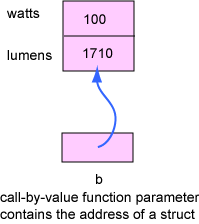

#include <stdio.h>
struct Bulb
{
int watts;
int lumens;
};
/* function to print a Bulb */
void printBulb( struct Bulb *blb )
{
printf("watts = %d\tlumens = %d\n", blb->watts, blb->lumens );
}
int main(int argc, char *argv[])
{
struct Bulb bulbA = {100, 1710 }, bulbB = {60, 1065};
printBulb( &bulbA );
printBulb( &bulbB );
system("PAUSE");
return 0;
}
Comments: Functions in ANSI C always use call by value for parameter passing. However, the value that is passed can be an address. The function call
printBulb( &bulbA );
passes a parameter which is the address of bulbA.
The ampersand in &bulbA means "address of".
This is just a single value -- a 32-bit address.
The function declaration shows that the function expects such an address:
void printBulb( struct Bulb *blb )
The asterisk in struct Bulb *blb means "follow an address".
A struct can be initialized in an initializer list:
struct Bulb bulbA = {100,1710};
The values in the list are assigned to the members of the struct, in order.